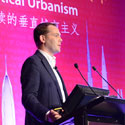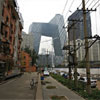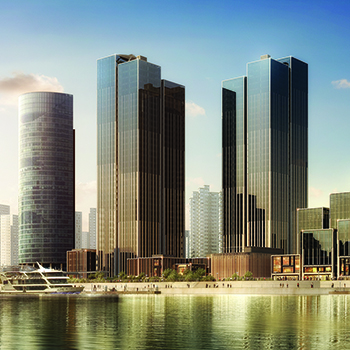Height rank
Shenzhen Stock Exchange
Shenzhen
-
Metrics
You must be a CTBUH Member to view this resource.
Official Name
Shenzhen Stock Exchange
Type
Building
Status
Completed, 2013
Country
City
Postal Code
518026
Function
A mixed-use tall building contains two or more functions (or uses), where each of the functions occupy a significant proportion of the tower's total space. Support areas such as car parks and mechanical plant space do not constitute mixed-use functions. Functions are denoted on CTBUH "Tallest Building" lists in descending order, e.g., "hotel/office" indicates hotel function above office function.
office
Structural Material
Both the main vertical/lateral structural elements and the floor spanning systems are constructed from steel. Note that a building of steel construction with a floor system of concrete planks or concrete slab on top of steel beams is still considered a “steel” structure as the concrete elements are not acting as the primary structure.
Reinforced Concrete
Both the main vertical/lateral structural elements and the floor spanning systems are constructed from concrete which has been cast in place and utilizes steel reinforcement bars.
Precast Concrete
Both the main vertical/lateral structural elements and the floor spanning system are constructed from steel reinforced concrete which has been precast as individual components and assembled together on-site.
Mixed-Structure
Utilizes distinct systems (e.g. steel, concrete, timber), one on top of the other. For example, a steel/concrete indicates a steel structural system located on top of a concrete structural system, with the opposite true of concrete/steel.
Composite
A combination of materials (e.g. steel, concrete, timber) are used together in the main structural elements. Examples include buildings which utilize: steel columns with a floor system of reinforced concrete beams; a steel frame system with a concrete core; concrete-encased steel columns; concrete-filled steel tubes; etc. Where known, the CTBUH database breaks out the materials used in a composite building’s core, columns, and floor spanning separately.
composite
Height
245.8 m / 806 ft
Floors Above Ground
46
Floors Below Ground
3
# of Parking Spaces
1973
# of Elevators
50
Top Elevator Speed
6 m/s
Tower GFA
170,000 m² / 1,829,865 ft²
-
By function
You must be a CTBUH Member to view this resource.
-
By material
You must be a CTBUH Member to view this resource.
Proposed
Construction Start
Completed
Structural Engineer
The Design Engineer is usually involved in the front end design, typically taking the leadership role in the Schematic Design and Design Development, and then a monitoring role through the CD and CA phases.
MEP Engineer
The Design Engineer is usually involved in the front end design, typically taking the leadership role in the Schematic Design and Design Development, and then a monitoring role through the CD and CA phases.
Other Consultant
Other Consultant refers to other organizations which provided significant consultation services for a building project (e.g. wind consultants, environmental consultants, fire and life safety consultants, etc).
Other Consultant refers to other organizations which provided significant consultation services for a building project (e.g. wind consultants, environmental consultants, fire and life safety consultants, etc).
These are firms that consult on the design of a building's façade. May often be referred to as "Cladding," "Envelope," "Exterior Wall," or "Curtain Wall" Consultant, however, for consistency CTBUH uses the term "Façade Consultant" exclusively.
You must be a CTBUH Member to view this resource.
Owner/Developer
Shenzhen Stock Exchange
Architect
Usually involved in the front end design, with a "typical" condition being that of a leadership role through either Schematic Design or Design Development, and then a monitoring role through the CD and CA phases.
Office for Metropolitan Architecture
Usually takes on the balance of the architectural effort not executed by the "Design Architect," typically responsible for the construction documents, conforming to local codes, etc. May often be referred to as "Executive," "Associate," or "Local" Architect, however, for consistency CTBUH uses the term "Architect of Record" exclusively.
Shenzhen General Institute of Architectural Design and Research Co., Ltd
Structural Engineer
The Design Engineer is usually involved in the front end design, typically taking the leadership role in the Schematic Design and Design Development, and then a monitoring role through the CD and CA phases.
MEP Engineer
The Design Engineer is usually involved in the front end design, typically taking the leadership role in the Schematic Design and Design Development, and then a monitoring role through the CD and CA phases.
Main Contractor
The main contractor is the supervisory contractor of all construction work on a project, management of sub-contractors and vendors, etc. May be referred to as "Construction Manager," however, for consistency CTBUH uses the term "Main Contractor" exclusively.
The main contractor is the supervisory contractor of all construction work on a project, management of sub-contractors and vendors, etc. May be referred to as "Construction Manager," however, for consistency CTBUH uses the term "Main Contractor" exclusively.
General Construction Company of CCTEB
Other Consultant
Other Consultant refers to other organizations which provided significant consultation services for a building project (e.g. wind consultants, environmental consultants, fire and life safety consultants, etc).
Other Consultant refers to other organizations which provided significant consultation services for a building project (e.g. wind consultants, environmental consultants, fire and life safety consultants, etc).
These are firms that consult on the design of a building's façade. May often be referred to as "Cladding," "Envelope," "Exterior Wall," or "Curtain Wall" Consultant, however, for consistency CTBUH uses the term "Façade Consultant" exclusively.
Inside Outside
Material Supplier
Material Supplier refers to organizations which supplied significant systems/materials for a building project (e.g. elevator suppliers, facade suppliers, etc).
Material Supplier refers to organizations which supplied significant systems/materials for a building project (e.g. elevator suppliers, facade suppliers, etc).
Armstrong World Industries
China Construction Steel Structure Corporation
CTBUH Initiatives
CTBUH Interviews Rem Koolhaas & David Gianotten from OMA
26 February 2014 - CTBUH Journal
Videos

18 September 2014 | Shenzhen
The Public Meaning of Skyscrapers: Shenzhen Stock Exchange and CCTV
David Gianotten from OMA presents at the 2014 Shanghai Conference closing plenary on "The Public Meaning of Skyscrapers: Shenzhen Stock Exchange and CCTV."
Research

16 September 2014
The Public Meaning of Skyscrapers: Shenzhen Stock Exchange and CCTV
David Gianotten, Rem Koolhaas & Sylvia Chan, OMA
Through the designs of Shenzhen Stock Exchange and the CCTV Headquarters in Beijing, the paper illustrates the potential of skyscrapers in creating public meaning. This...
About Shenzhen Stock Exchange
The Shenzhen Stock Exchange is a Financial Center with civic meaning. Located in a new public square, it engages the city not as an isolated object, but as a building to be reacted to at multiple scales and levels. The tower is flanked by two atria, one for staff and one for tenants – voids that connect the ground directly with the public spaces inside the building.
SZSE’s raised podium is a three-story cantilevered platform floating 36 meters above the ground, with an area of 15,000 square meters per floor and a landscaped roof. The raised podium contains all the Stock Exchange functions, including the listing hall and all stock exchange departments. SZSE executive offices are located just above the raised podium, which vastly increases SZSE’s exposure in its elevated position and frames views of the city. But it also liberates the ground level and creates a generous public space beneath a secure, private building.
Research

16 September 2014
The Public Meaning of Skyscrapers: Shenzhen Stock Exchange and CCTV
Through the designs of Shenzhen Stock Exchange and the CCTV Headquarters in Beijing, the paper illustrates the potential of skyscrapers in creating public meaning. This...

14 September 2014
Towards Sustainable Vertical Urbanism
The survival of humanity on this planet relies on a radical repositioning of our cities. In the face of unprecedented global population growth, urbanization, pollution...
butyrskii_igor.jpg)
26 February 2014
On the occasion of receiving the Best Tall Building Worldwide award at the 12th Annual CTBUH Awards Symposium and Dinner for CCTV Headquarters, Beijing, Rem...
Subscribe below to receive periodic updates from CTBUH on the latest Tall Building and Urban news and CTBUH initiatives, including our monthly newsletter. Fields with a red asterisk (*) next to them are required.
View our privacy policy


























